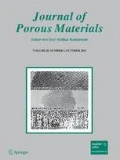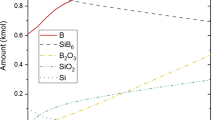Abstract
The gaseous species desorbed from porous silicon (PS) were investigated using the method of temperature programmed desorption (TPD) and fourier transform infrared spectroscopy (FTIR). Silicon wafers (25–50 Ω cm, p−, FZ) were anodised in 40% HF and HF/C2H5OH electrolytes. The PS samples were linearly heated at 1.5 K s−1 using a custom built heating unit in a oil-free pump backed vacuum chamber at a base pressure of <10−8 torr. A quadrupole mass spectrometer, which was used as the detector, was fitted in line of sight of the sample at a distance of about 6 mm. It was observed that silane was liberated during the heating of porous silicon samples produced from both electrolytes. The peak temperature at which this occurred was at 570 ± 10 K. This temperature coincides with the temperature of silicon-silicon bond breakage in ≡Si–SiH3 groups on the pore walls, as shown by the FTIR results. It is proposed that silane formation involves the reaction of the Si-silyl group with moisture: ≡Si–SiH3 + H2O → ≡Si–OH + SiH4.
Similar content being viewed by others
References
L. Pavesi, Microelect. J 27, 437 (1996).
W. Lang, P. Steiner, and H Sandmaier, Sensors and Actuators A51, 31 (1995).
Y.S. Tsuo, Y. Xiao, and C.A. Moore, in Porous Silicon, edited by Z.C. Feng and R. Tsu (World Scientific, Singapore, 1994), p. 347.
L.T. Canham, M.R. Houlton, W.Y. Leong, C. Pickering, and J.M. Keen, J. Appl. Phys. 70, 422 (1991).
A. Grosman, C. Oretaga, J. Siejka, and M. Chamarrow, J. Appl. Phys. 74, 1992 (1993).
L.G. Earwaker, J.P.G. Farr, I. Alexander, I. Sturland, and J.M. Keen, Nucl. Inst. Meth. Phys. Res. 218, 481 (1983).
R. Sabet-Dariani, D. Haneman, A. Hoffman, and D.D. Cohen, J. Appl. Phys. 73, 2321 (1993).
S. Zhang, X. Wang, K.S. Ho, J. Li, P. Diao, and S. Cai, J. Appl. Phys. 76, 3016 (1994).
H. Sugiyama and Q. Nittono, Jpn. J. Appl. Phys. 28, L2013 (1989).
Y. Ogata, H. Nikki, T. Sakka, and M. Iwasaki, J. Electrochem. Soc. 142, 195 (1995).
I. Lampert, H. Fusstetter, and H. Jacob, J. Electrochem. Soc. 133, 1472 (1986).
L.T. Canham, S.J. Saunders, P.B. Heeley, A.M. Keir, and T.I. Cox, Adv. Mater. 6, 863 (1994).
A.G. Cullis, L.T. Canham, and P.D.J. Calcott, J. Appl. Phys. 82, 909 (1997).
Author information
Authors and Affiliations
Rights and permissions
About this article
Cite this article
Gunasingam, P.V., Goldspink, G. An Investigation into Silane Evolution from Porous Silicon by Temperature Programmed Desorption Method. Journal of Porous Materials 7, 187–190 (2000). https://doi.org/10.1023/A:1009682603598
Issue Date:
DOI: https://doi.org/10.1023/A:1009682603598



